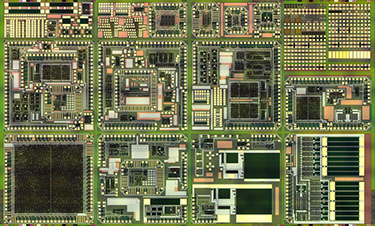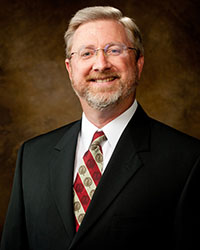NSF Grant Will Further Development of High-Temperature Integrated Circuits

A die micrograph, or photograph of a semiconductor die taken by a microscope. The die is part of an integrated circuit made of silicon-carbide.
FAYETTEVILLE, Ark. – Engineering researchers at the University of Arkansas have received an additional $200,000 grant from the National Science Foundation to continue developing integrated circuits that can survive and operate at temperatures greater than 300 degrees Celsius – equivalent to roughly 600 degrees Fahrenheit.
The integrated circuits serve as the foundation for creating commercial converters that reside within internal combustion engines. These convert high-temperature sensor data to digital form for transmission to the vehicle’s performance and emissions control computer. The technology should provide more robust data from the engine, enabling better control of the vehicle and greater fuel efficiency.
 |
| Alan Mantooth |
The research team, led by Alan Mantooth, Distinguished Professor of electrical engineering, is one of only a few groups nationwide with extensive experience designing and fabricating integrated circuits made of silicon carbide, a semiconducting material that is more rugged than conventional materials used in electronics. Silicon carbide is a good thermal conductor, able to withstand extremely high voltage and temperatures.
For this project, the U of A researchers collaborate with Ozark Integrated Circuits, a Fayetteville technology firm that develops integrated circuits for remote sensing and actuation under extreme environmental conditions. Ozark Integrated Circuits will commercialize the new circuit technology.
Together, these researchers intend to create a prototype of a silicon carbide-based converter that can acquire and process data in harsh environments. They will then evaluate the prototype across temperature variations and test how the converter functions in a harsh, real-world environment by combining the system with ignition sensor technology developed by Ozark Integrated Circuits. Finally, the team plans to generate a commercial feasibility analysis based on projections of the manufacturing costs of a high volume of silicon carbide.
Mantooth holds the Twenty-First Century Chair in Mixed-Signal Integrated Circuit Design and Computer-Aided Design in the College of Engineering. He is also executive director of the National Center for Reliable Electric Power Transmission, a 7,000-square-foot, $5-million power electronic test facility at the University of Arkansas.
About the University of Arkansas: The University of Arkansas provides an internationally competitive education for undergraduate and graduate students in more than 200 academic programs. The university contributes new knowledge, economic development, basic and applied research, and creative activity while also providing service to academic and professional disciplines. The Carnegie Foundation classifies the University of Arkansas among only 2 percent of universities in America that have the highest level of research activity. U.S. News & World Report ranks the University of Arkansas among its top American public research universities. Founded in 1871, the University of Arkansas comprises 10 colleges and schools and maintains a low student-to-faculty ratio that promotes personal attention and close mentoring.
Contacts
Alan Mantooth, Distinguished Professor, electrical engineering
College of Engineering
479-575-4838,
mantooth@uark.edu
Ian Getreu, director of business development and partnerships
Ozark Integrated Circuits, Inc.
479-935-1600,
getreu@ozarkic.com
Matt McGowan, science and research communications officer
University Relations
479-575-4246,
dmcgowa@uark.edu
Headlines
Honors College to Host Pulse Discussion Around Baltimore Bridge Accident
The Honors College will present a panel of faculty with expertise on engineering, labor history and supply chain to discuss the impact of the accident at 3:30 p.m. Wednesday, April 24, in Gearhart Hall, room 258.
Entrepreneurial Path Follows Tradition and Family Legacy
When Blanca Ruiz made a pivotal career decision to pursue a newfound passion rooted in a family legacy, she took advantage of training through the U of A Small Business Center.
'Peace' Sculpture by Native American Artist Dedicated at Adohi Hall
The 33-inch high bronze sculpture, created by Native American artist Retha Walden Gambaro in 1997, features a dove in two hands and titled simply "Peace," was donated by Richard Anderson and John Berry.
Cyber Careers with University SFS Alum Calvin Franz on April 25th
Alumnus Calvin Franz will be joining the CyberHogs RSO to talk about what it's like post-graduation as a cybersecurity developer in the public sector at 5 p.m. Thursday, April 25, at J.B. Hunt Center room 0216.
Take a Study Break in Mullins Library
As finals approach, the University Libraries have teamed up with partners across campus to offer study breaks in the east lobby of Mullins Library that are free and open to all U of A students.




